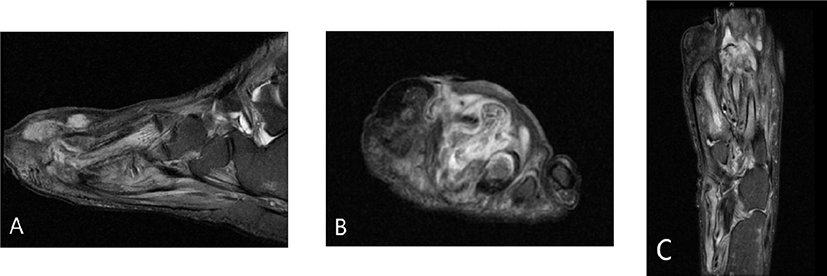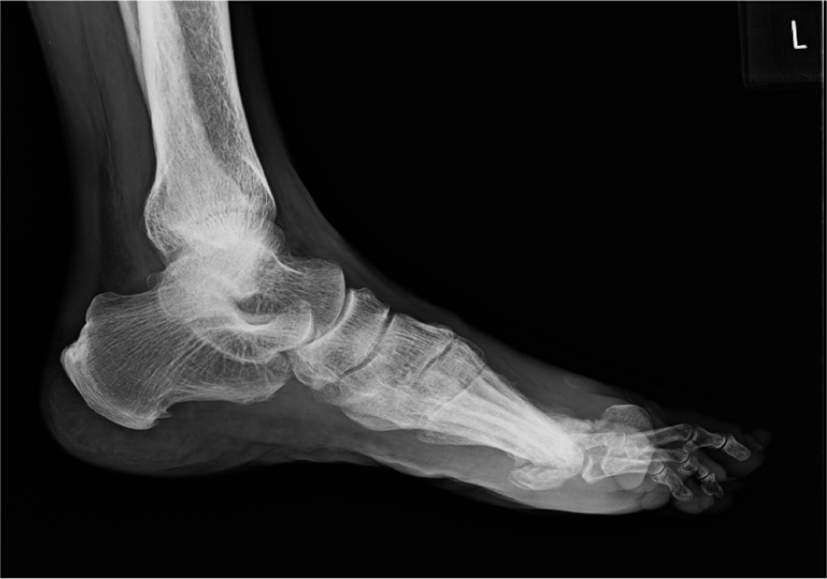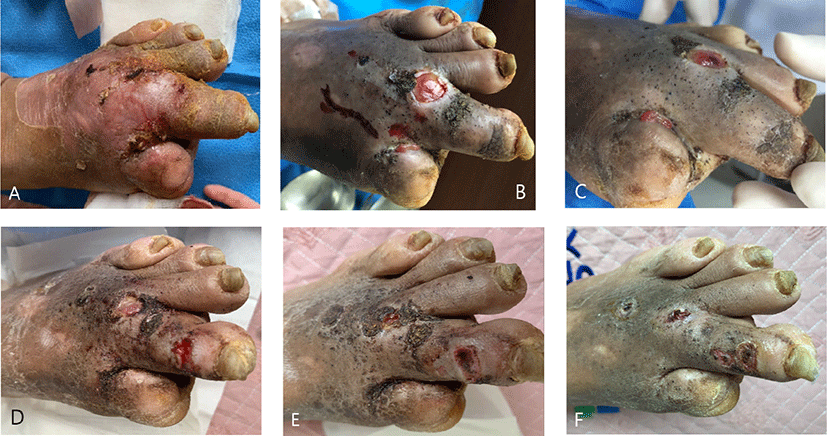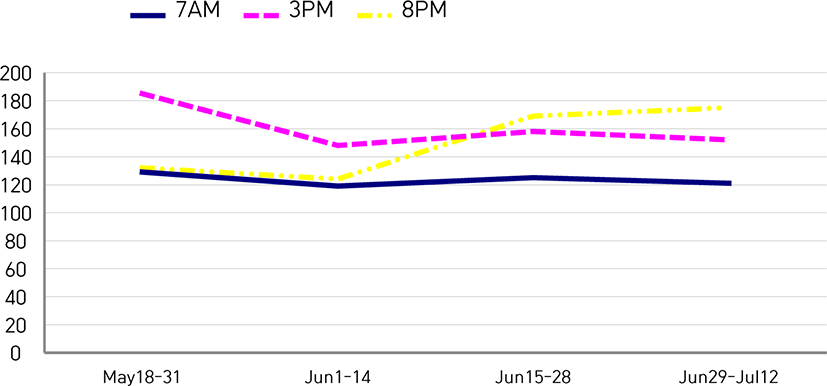I. Introduction
Diabetic foot ulcer, also known as Charcot neuroarthropathy(CN), is a sensorial neuropathy, defined as a non-infectious and progressive invasion and destruction of bones, joints, soft tissues1). CN is a result of peripheral neuropathies from diabetes, autonomic neuropathy, infections such as leprosy and HIV, drinking alcohol, tabes dorsalis, syringomyelia, rheumatoid arthritis, multiple sclerosis, traumatic damage, or abnormal bone metabolism2). CN easily occur on midfoot, causing subluxation, dislocation, fracture and deformation of surrounding.
Diabetes is the most prominent cause of CN, of which annual incident rate is about 0.1-29% worldwide. About 0.08-13% of world population is diabetic patients3), For diabetic patients, CN is a long-term complication which damages foot and foot joints, resulting dislocation, instability, joint deformation, insensibility, joint alignment destruction, progressive fracture, and multiple joint dislocation. Ulceration may develop to myelitis and at worst amputation would be necessary1).
In Korean medicine, CN can be comprehended in categories of wasting-thirst(消渴) and digital gangrene(脫疽). Dongeuibogam(東醫寶鑑) mentions digital gangrene is caused by accumulated toxin due to excessive indulgence in greasy and sweet food(膏粱珍味), sexual overindulgence(房勞), drinking alcohol(酒毒), or developed as a long-term complication of wasting-thirst4). Lingshu(靈樞) contains prognosis information of digital gangrene based on color and morphology, and mentions amputation surgery procedures when it threats patient’s life. Dongeuisoosebowon(東醫壽世保元) classifies types of wasting-thirst, its complication patterns, and treatments based on constitutional type5-7).
There was a case report of 5 patients all with different disease or symptom, but same as Soyang(lesser yang person) type gangrene according to pattern identification(辨證), treated with same herbal prescription, Soyang type Liuweidihuang-tang(六味地黃湯)6). However, there is no study of CN treatment with Korean medicine yet.
This study reports a case of CN as a complication of long-term diabetes improved by combined Korean medical treatment including Shudihuangkushen-tang(熟地黃苦蔘湯) and Haifu-san(海浮散) wet dressing.
II. Objects & Methods
One patient with CN as a long-term complication of diabetes was studied. On May 2, 2020, the patient was fully explained the purpose of this study and agreed by consent form that his medical information would be used for this study and publication.
Edema improvement was measured on visual analogue scale(VAS), 10 the worst, 0 the absence of edema.
III. Case report
-
Patient : ○○○ (M/59)
-
Chief complaint
-
Onset : April, 2004 gradually recurred in 2018.
-
Past history
-
Family history
-
Present illness
A 59-year-old male patient was diagnosed with diabetic foot on the left side and had an amputation surgery on distal interphlangeal joint of left first toe in 2004. After a gradual relapse of edema, paresthesia and ulceration on the left foot in 2018, he started Korean medical treatment on May 18, 2019.
-
Initial opinion
-
1) Hight/Weight : 179.6cm/70.2kg, lean body and upper excess and lower deficiency(上盛下虛) type
-
2) Digestion : Normal
-
3) Appetite : Normal
-
4) Sleep : 6-7hours/day
-
5) Voiding : 6-7times/day, foamy
-
6) Defecation : 1time/2-3days, hard
-
7) Sweating : night sweating
-
8) Tongue diagnosis
-
9) Pulse diagnosis(wrist)
-
10) Pattern identification : Soyang type lower wasting-thirst(少陽人 下消) based on ordinary symptom(素證), disease pattern(病證), appearance and style of talking(容貌詞氣) and physical appearance(體形氣像).
-
-
Examination results
-
1) Left foot X-ray(Fig. 1)
-
2) Left foot MRI(Fig. 2)
-
3) Clinical pathology(May 20, 2019)
-
① Hematology : RBC 4.02(4.29-5.70 10^6/㎕), Hb 11.4(13.3-16.6g/㎗), Hct 34.3(41.3-52.1%), MCV 85.3(86.1-101.9fL), RDW-SD 38.2 (39.9-52.2fl), RDW-CV 12.0(12.2-14.6%), Lympho 22.8(24.0-48.4%), ESR(Westergren Method) 70.0(0-15mm/hr), Others : WNL
-
② Blood chemistry : Cholesterol Total 124.0(136-220㎎/㎗), HDL-Cholesterol 32.5 (40-87㎎/㎗), CK 55.0(58-348U/L), Glucose (PP2hrs) 254.0(60-140㎎/㎗), C-Peptide 1.86(1.10-4.40ng/㎖), Hb A1c-NGSP 9.5(≤5.6), Hb A1c-IFCC 81.0(≤38), Hb A1c-eAG 226.0, Others : WNL
-
③ Urine analysis : RBC 1-3/HPF(0-2/HPF), Others : WNL
-
④ HBsAg(-), Ab(+)
-
-
-
Treatments
-
1) Herbal medicine
Shudihuangkushen-tang was prescribed and administered three times a day in decoction. For first 21 days Rehmanniae Radix Preparata from the original formula of Shudihuangkushen-tang was substituted for Rehmanniae Radix Recens, and for the latter 33 days the herbal medicine was prepared according to the original formula(Table 1).
-
2) Wet dressing
Wet dressing was daily practiced. After the ulceration area was wiped out with boric acid, hydrogen peroxide, povidone-iodine solution, and Haifu-san preparation were applied in order(Table 2).
-
3) Acupuncture
Acupuncture treatment was practiced two times a day. Size of 0.3×30mm, stainless, standardized and disposable filiform needle(HL Medical HL-001 SERIES, Yeoju, Korea) were used.
Acupuncture technique was practiced based on the concept of Taegeuk acupuncture. Soyang type Taegeuk acupuncture treatment was applied, in which selected meridian points are HT3, KI3, SP3, LI11, LI4, ST368). After Haifu-san wet dressing, acupuncture treatment was also applied directly on the left foot ulcer area.
Infra-red light was applied to the patient’s left foot for 20 minutes needle retention.
-
4) Herbal acupuncture
Anti-inflammatory herbal acupuncture was injected to the left foot ulceration area nine times from May 20 to June 3, and Jahageo herbal acupuncture, which consists of Hominis placenta, was injected seven times to the same area from June 4 to 20 in 2019. Both kinds of herbal acupuncture were supplied from Korean Pharmaco-puncture Institute.
-
-
Clinical progress
During treatment period, from May 18 to July 12 in 2019, blood sugar level decreased in the second quarter compared to the first quarter. Then 7AM and 3PM blood sugar level fluctuated through the latter half, increased in the third and decreased in the forth quarter. 8PM blood sugar level consistently increased through the latter half, and it went up higher than the first quarter. HbA1c level was 9.5% at admission, but dropped to 7.7% when discharged(Fig. 3, Table 3).
Edema and pain sensation was scored 6 and 0 on VAS respectively. Edema gradually improved to 1 at the end of treatment. Pain sensation was not improving until he began to feel needle pricking stimulation on June 27 when acupuncture treatment was practiced on the foot ulcer area(Table 4). Pain sensation VAS score did not get better afterward.
When lateral view X-ray radiograph of at admission and before discharge were compared to each other, improvement of edema on the left foot could be found(Fig. 4). Photographs showed improvement of redness and edema as treatment proceeded(Fig. 5).


| Herbal name | Scientific Name | Dose(g) |
|---|---|---|
| 乳香 | Olibanum | 4 |
| 沒藥 | Myrrha | 4 |
| Date | Edema | Pain |
|---|---|---|
| May 18 | 6 | 0 |
| May 30 | 5 | 0 |
| June 5 | 4 | 0 |
| June 10 | 3 | 0 |
| June 27 | 3 | 1 |
| July 2 | 2 | 1 |
| July 11 | 1 | 1 |


IV. Discussion
Charcot neuroarthropathy is a sensorial neuropathy involving a non-infectious and progressive invasion and destruction of bones, joints, soft tissues1). CN easily occur on midfoot area as a result of peripheral neuropathies from diabetes, autonomic neuropathy, infections such as leprosy and HIV, drinking alcohol, tabes dorsalis, syringomyelia, rheumatoid arthritis, multiple sclerosis, traumatic damage, abnormal bone metabolism2), causing subluxation, dislocation, fracture and deformity of surrounding.
Main cause of CN is diabetes. About 9.3% of American population, 0.08-13% of world population have diabetes, and its annual incident rate is 0.1-29% worldwide3). According to domestic statistics from National health insurance in Republic of Korea, the number of diabetic patients increased by 24.6%, from 2.02 million in 2010 to 2.52 million in 20159). Among diabetic patients, prevalence rate of CN varies from 0.08 to 7.55%, but it seems underestimated because of misdiagnosis, such as goat, deep vein thrombosis, soft tissue damage, rheumatoid arthritis, and infection10-12), which delays time to get proper treatment and brings severe deformation of affected area1).
For diabetic patients, CN is a long-term complication which invades foot and foot joints, causing dislocation, instability, and joint deformation, and as sensorial neuropathy gradually proceeds, sensation becomes numb. Inappropriate treatment after loss of joint alignment or traumatic damage may cause progressive fracture or multiple joint dislocation. When ulcer develops to osteomyelitis, in severe cases, amputation would be required1). Statistically about 50% of CN patients get at least one time surgery, and ulcer or inflammation are common complications. CN, for diabetic patients, is a major risk factor for below-the-knee amputation3).
Although the pathophysiology of CN is not yet fully discovered, neurotraumatic theory and neurovascular theory generally explain the mechanism of CN. According to neurotraumatic theory, as distal area becomes gradually insensitive and less aware of external stimuli, repetitive small damage causes successive reaction of infection, finally developing to CN. Neurovascular theory says that blood flow to distal extremities increases because of sympathetic nerve abnormality, resulting blockage of blood vessels, fever, swelling, bone absorption and osteolysis consequently, which leads to fracture even by small amount of load3,13). Combination theory is suggested based on two theories above, which explains that inflammatory cytokines promote inflammation and activate osteoclasts14). Osteolysis causes pain, and pain makes patients rest and apply immobilization which slows and limits inflammatory reactions. CN patients are insensitive to pain, and therefore cannot be helped by immobilization, leading to osteoclasia and osteolysis1,3,15). As it moves to chronic stage, deformation, dislocation in instability, and bone protrusion which may lead to superficial or deep tissue ulcer and osteomyelitis16).
Diagnosis of CN is made based on medical history and physical examination, referring to laboratory investigations and radiograph3). Typical symptoms of CN are swelling, instability, painless sensation, but in some cases might feel somewhat pain1). Patients usually show warm, swollen, erythematous foot or ankle. Physicians have to check if neuropathy affects the other side1). Differential diagnosis of foot infections is necessary, such as cellulitis, abscess, osteomyelitis which also show edema, redness, and heat, similar to CN. CN patients do not present with systemic fever, increase of white blood cell, erythrocyte sedimentation rate, C-peptide, glucose, which implies systemic infection. If there is no external wound, it would help to diagnose neuropathy, but infection and neuropathy could be simultaneous. If edema and redness lessen as the leg is raised for two minutes, it could help to rule out infection1,2,13).
In early stage, CN is treated conservatively, such as disinfection of ulcer area, application of total contact cast for immobilization and off-loading of the affected extremities, or pharmacological management to control bone metabolism. If conservative treatment fails, surgical treatment would be necessary such as debridement, soft tissue transplantation, exostectomy, arthrodesis, or amputation. In treating CN, debridement is the most important, which is removing dead tissue from infected area, such as callus, bone, tendon, cartilage, especially bone and tissue with osteomyelitis. The common goal of treatment methods is to obtain a stable and plantigrade shoe wearable foot, preventing recurrence of ulceration, minimizing foot deformation, and helping to progress into bone remodeling stage3).
CN can be comprehended in categories of wasting-thirst and digital gangrene. Dongeuibogam mentions digital gangrene is caused by accumulated toxin due to excessive indulgence in greasy and sweet food, sexual overindulgence, drinking alcohol, or developed as a long-term complication of wasting-thirst4). Lingshu contains information about prognosis of digital gangrene based on color and morphology, and mentions amputation surgery procedures when it worsens and threats patient’s life. Dongeuisoosebowon classifies types of wasting-thirst, its complication patterns, and treatments based on constitutional type5-7), Soyeum(lesser yin person) type Shikso(食消), Soyang type upper, middle, lower wasting-thirst(上·中·下消), Taeyeum(greater yin person) type Iyanggeolwijiso(二陽結謂之消), and complications of wasting-thirst such as Soyeum type near brest carbuncle(乳傍近脇 發內癰), sore covered all over the body(滿身有瘡), back carbuncle(背癰), Soyang type carbuncle(癰疽), eye diseases(眼病), poisonous gall on shoulder(肩上有毒瘇), nuchal gangrene(腦疽), sore on fingertip(蛇頭瘡), lymphatic infection(連珠痰), Taeyeum type fingertip black sore disease(手指焦黑癍瘡病).
There was a case report of 5 different patients, all Soyang type gangrene based on pattern identification, treated with same herbal prescription, lesser yang person type Liuweidihuang-tang. However, there is no study of CN treatment with Korean medicine yet.
This study reports a case of CN as a complication of long-term diabetes improved by Korean medical treatment combined with herbal medicine, Shudihuangkushen-tang, Haifu-san wet dressing, acupuncture, and herbal acupuncture.
A 59-year-old male patient was diagnosed with CN on April in 2004, and had amputation surgery on distal interphalangeal joint of the left foot first toe. Ulceration gradually recurred on the left foot in 2018. After self management failed, the patient visited and started Korean medical treatment on May 18 in 2019. Edema, redness, heat was observed on the left foot, and he felt painless on the first, second, and third toe at admission. With elevated ESR level to 70mm/hr, and normal white blood cell count, systemic infection was not observed. Therefore conservative treatments were performed with herbal medicine, acupuncture, herbal acupuncture treatment, wet dressing on ulceration site, without using antibiotics and surgical treatment.
The patient's symptoms were fit to the description of sore on fingertip. Shudihuangkushen-tang was prescribed for entire treatment period, following Soyang type lower wasting-thrist treatment mentioned in Dongeuisoosebowon. From May 20 to June 9 Rehmanniae Radix Preparata from the original formula of Shudihuangkushen-tang was substituted for Rehmanniae Radix Recens to clear heat and to cool the blood(淸熱凉血), and for the latter 33 days the herbal medicine was prepared according to the original formula, using Rehmanniae Radix Preparata originally to enrich yin and tonify blood(滋陰補血)17). Herbal medicine was served in decoction, three times a day.
Wet dressing was daily practiced with Haifu-san which consists of Olibanum and Myrrha. Haifu-san is reported to be effective in wound recovery, accelerating generation of granulation tissue with increased collagen content, and more effective as a combination formula than Olibanum or Myrrha alone18). Haifu-san was prepared by decocting same amount of Olibanum and Myrrha for an hour into 500㎖. Haifu-san was applied after wiping out ulceration area with boric acid, hydrogen peroxide, povidone-iodine solution in order.
Taegeuk acupuncture treatment was performed two times a day. Selected meridian points are HT3, KI3, SP3, LI11, LI4, ST36 according to Soyang type Taegeuk acupuncture theory8). Taegeuk acupuncture technique was reported to be effective in treating problems of autonomic neuropathy and circulation, which are the mechanism of CN suggested by the neurovascular theory19).
Two kinds of herbal acupuncture were used, anti-inflammatory and Jahageo. From May 20 to June 3, anti-inflammatory herbal acupuncture was injected around ulceration area to clear heat and to cool the blood(淸熱凉血) and to clear heat and detoxicate(淸熱解毒)20), and from June 4 to July 12 Jahageo, which consists of Hominis placenta, was injected to keep the skin hydrated and strengthen skin barrier21-22).
After treatment, edema was almost subsided, and edema improvement was also found in X-ray comparison. VAS score of edema was improved from 6 to 1. Photographs showed gradual improvement of redness and edema. The patient felt painless on the first, second, and third toe of the left foot before treatment, but since June 27, he started to feel a slight pricking pain when acupuncture needle was inserted. VAS score of pain sense was slightly improved from 0 to 1, but did not get better afterward.
Average blood sugar level decreased in the first half of treatment period, but in the latter half blood sugar level of 7AM and 3PM fluctuated, and that of 8PM increased again, higher than the first quarter. HbA1c was improved from 9.5 to 7.7%. Overall management of blood sugar level seemed to be successful, but third and fourth quarters would be better if the patient did diet control better. As edema and blood sugar level got better, the patient felt relieved and went out for dinner frequently.
In this case, after recurrence of CN, the affected area was treated without surgical treatment including debridement which is important. That means, in conclusion, conservative treatment with Korean medicine prevented further ulceration, helped to recover and ambulatory. Although improvement was confirmed by Korean medical treatment, to claim its effectiveness and generalize there are limitations as follow. Case size is only one, the treatment was not complete, and blood sugar level management was not fully satisfactory. Pain sensation recovery was positive but poor. Treatments were combined to improve symptoms, making it difficult to evaluate therapeutic effect of each treatment. Though this case would be helpful for CN patients without infections so conservative treatments can be considered as an option. Further study would be necessary if conservative Korean medical treatments practiced in this case are adequate for CN patients in need of surgical treatment.
V. Conclusion
A patient diagnosed as Charcot neuroarthropathy, and Soyang type lower wasting-thirst according to pattern identification, was conservatively treated with Korean medical treatment combined with Shudihuangkushen-tang, Haifu-san wet dressing, acupuncture, and herbal acupuncture. As a result, the following conclusions were drawn, and improvement of symptoms was confirmed
-
The overall blood sugar level decreased in the first half but rebounded or fluctuated afterward. HbA1c was improved from 9.5 to 7.7%.
-
Edema was almost subsided from VAS 6 to 1.
-
Pain sense was slightly improved from VAS 0 to 1.
-
Comparison of X-rays and photographs of before and after treatment showed redness and edema improved.







